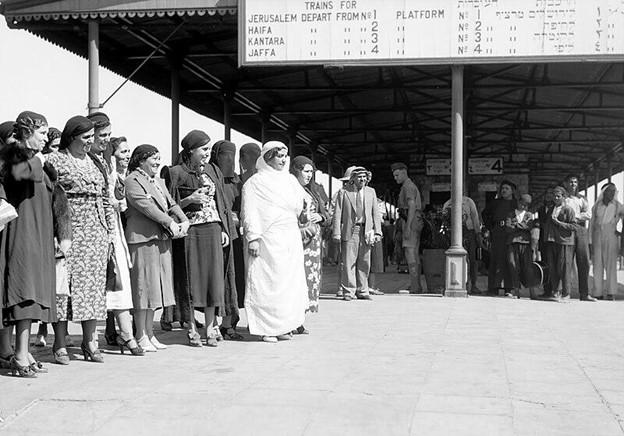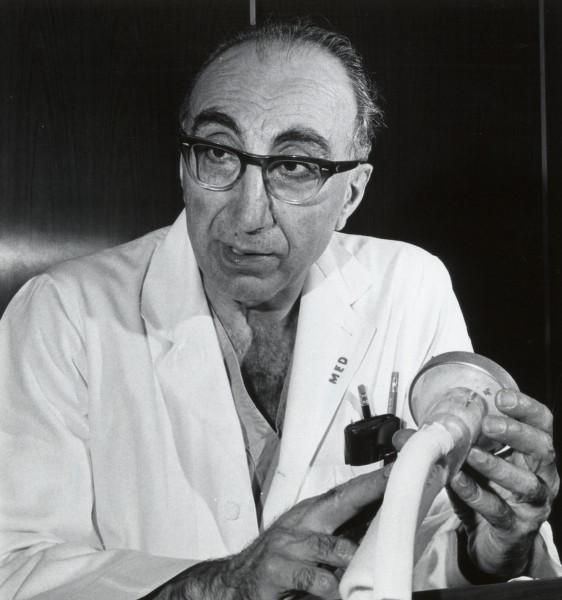The world’s largest online family history resource - Start now
-
Using DNA to Trace Your African American Heritage -
Daisy Bates Day in Arkansas -
Black History Month – Ancestry Initiatives to Honor Black Heritage -
Marking 80 Years Since Auschwitz Liberation: Our Commitment to Holocaust Remembrance
GET THE LATEST
New posts + monthly newsletter.
GET THE LATEST
New posts + monthly newsletter.
Arab Americans are responsible for advances in diplomacy, science, technology, civil rights, social justice, art, and culture. The U.S. Department of State estimates that Arab Americans account for around 3 million members of the country’s population. While the Arab America Foundation started an initiative to celebrate Arab American Heritage Month in 2017, the official recognition of it by the government and the nation is much more recent.
Since 2022, the United States has dedicated the month of April to celebrating Americans with Middle Eastern and North African (MENA) heritage through social events and public education. The goal of this heritage month is to acknowledge the contributions of Arab Americans to the country. Find out how Arab American Heritage Month came to be and how Arab Americans have positively influenced life in the United States.
Origins of National Arab American Heritage Month
The inception of this important celebration began in 2021 when the White House released a letter on April 19, addressing Arab America and the Arab America Foundation. In this letter, Biden acknowledged Arab American Heritage Month on a federal level for the first time and thanked the organizations for including him in the chance to celebrate the important history of Arab Americans.
However, it wasn’t until 2022, United States President Joe Biden officially declared April to be National Arab American Heritage Month. In a speech at the time of the announcement, Biden acknowledged the role that Arab American play in the diverse tapestry of the nation and how their innovations have positively impacted the United States long before the country gained its independence. In the wake of the official announcement, members of the Arab American community expressed enthusiasm and appreciation for a national opportunity to shine a light on the bias that many Arab Americans deal with daily. The month is dedicated to celebrating all Americans of Middle Eastern and North African (MENA) Heritage and their contributions to the United States.
On the eve of Arab American Heritage Month 2023, Biden addressed the nation about the reason for the new celebration, saying, “The Arab American story is the American story — one of diverse backgrounds and faiths, vibrant tradition, bold innovation, hard work, commitment to community, and stalwart patriotism, all coming together to accomplish something greater than any one of us.”
Biden also acknowledged in his address that while Arab Americans have done much to shape the nation, they continue to face instances of violence, bigotry, and prejudice in America. Arab American Heritage Month is a positive step toward ensuring Arab Americans feel safe and welcome in the United States.

Arab Immigration to the United States
There have been four waves of significant immigration to America from Arab nations, of which there are 22 today. The first was people leaving the Ottoman Empire in the late 1880s and early 1900s. During this time, over 90,000 immigrants came to the United States from the Ottoman Empire, including the countries known today as Lebanon, Jordan, Palestine, Israel, and Syria.
Another wave of immigration occurred due to the Refugee Relief Act of 1953, which provided refugee visas to people in Communist Europe and East Asia. At that time, some of these were reallocated and around 2,000 Palestinian families arrived in the United States, citing the loss of a safe home due to political reasons.
Yet another increase in Arab immigration to America occurred in the late 1960s to the 1990s, with around 400,000 people arriving in the United States from Arab nations. Some were refugees fleeing conflict in their homeland, but others were pursuing education in the United States or were professionals who wanted to work in America.
Today, an estimated 3 million Arab Americans are an integral part of the population of the United States. Approximately 12% of Arab Americans work for the federal, state, or local governments of the United States.

Contributions and Achievements of Arab Americans
There have been countless valuable contributions to the United States across various fields by individuals born in or with heritage from Arab nations. Here are some notable inventions and societal contributions by Arab Americans.
Internet Security
Egyptian-born cryptographer Taher Elgamal began work on internet security protocols in the 1980s. He’s credited with creating the software for the Digital Signature Algorithm (DSA), which became the gold standard for electronic signatures in the United States. He’s also responsible for the creation of the Secure Sockets Layer (SSL) protocol to keep digital communication secure.
Surgical Advancements
An American born to Lebanese immigrants, Michael DeBakey is a medical professional who served in the Surgical Consultants Division of the Army Surgeon General’s Office between 1942 and 1946. During his employment there, he developed Mobile Auxiliary Surgical Hospital (MASH) units, which were deployed in Vietnam and Korean conflict zones in 1943. He was the first person to successfully remove a carotid artery blockage and developed a method for coronary bypass.
The iPhone and iPod
Apple’s founder Steve Jobs is always credited with these inventions, now used in most Americans’ daily lives. But Anthony “Tony” Fadell is the Arab American engineer who co-created these devices and oversaw their development.
Postcolonial Studies in Academia
Edward W. Said was a Palestinian American professor of literature at Columbia University and a founder of the field of postcolonial studies, making him an important name in the academic world.
Famous Arab Americans
There are plenty of famous Arab Americans who have created a name for themselves in the United States and around the world in various fields from the arts and sciences to academia. These are some of the Arab American Heritage Month figures who stand out for their achievements in the United States.
Tony Shalhoub
Tony Shalhoub (born Anthony Marcus Shalhoub) was born in Wisconsin to Lebanese parents. He is famous for several roles in popular TV series, including The Marvelous Mrs. Maisel and The Company You Keep.
Gigi Hadid
Jelena Noura “Gigi” Hadid is an American model who is proud of her Palestinian heritage. She posted an Instagram photo reminding fans of her roots, captioning it, “Check out the last name. Hadid. Half Palestinian & proud of it.”
Rami Malek
Although actor Rami Malek was born in California, his parents are Egyptian. The actor shot to stardom after his particularly Oscar-winning role as Freddie Mercury in the Queen biopic Bohemian Rhapsody. Although he is no longer fluent, Rami Malek spoke to reporters in Arabic following his Oscar win when asked what he would say to young aspiring actors.
Farouk El-Baz
Farouk El-Baz is an Egyptian-born American citizen who was the lead geologist for the Apollo space program at NASA. Today, he’s a professor and director of the Center for Remote Sensing at Boston University. El-Baz’s impressive work in geology includes finding groundwater resources in Egypt, Oman, Somalia, Sudan, and the United Arab Emirates.
Arab American Heritage Month Celebrations
Since this is still a fairly new month of celebration in the United States, you might be wondering how to celebrate Arab American Heritage Month and what kinds of activities can get people involved in learning about Arab American contributions to society.
There are lots of ways to celebrate Arab American Heritage Month and champion Arab American voices in the process. If you’re an educator looking to bring lessons about NAAHM to the classroom, consider assigning books by Arab American authors or watching a documentary about Arab American history.
The general public can show support for the Arab American community during the month of April by shopping at Arab-American-owned local businesses and advocating for a MENA category to be added to the official US Census survey.
More Arab American Heritage Month Facts to Know
Since it’s a national heritage month, the entire country recognizes the celebration, but only a select few states have taken action to put the celebration of Arab American Heritage Month into law. Illinois, Virginia, Oregon, and Indiana have officially passed legislation that designates the month of April as National Arab American Heritage Month.
California is the U.S. state with the largest Arab American population, while Wyoming has the smallest (under 300).
To learn more about Arab American Heritage Month history, check out the official website of the Arab America Foundation.
Discovering Your Arab Ancestors
National Arab American Heritage Month is the ideal time to delve deeper into your family’s past and learn about where your story began. If you’re an Arab American looking to trace your heritage, several options are available to you. AncestryDNA® testing can help you uncover familial roots when you aren’t sure which part of the Middle East or North Africa your relatives are originally from.
If you already know where your parents, grandparents, or ancestors were born, you might be able to simply trace your heritage using surnames. Start a free trial of Ancestry® and begin building your family tree to find new details about your family’s story.
https://www.newarab.com/features/what-does-arab-heritage-month-mean-arab-americans
https://www.arabamerica.com/wp-content/uploads/2021/04/White-House.Message-from-President-Biden-to-Arab-America_Mailed-via-USPS-4.21.21.pdf
https://www.whitehouse.gov/briefing-room/presidential-actions/2023/03/31/a-proclamation-on-arab-american-heritage-month-2023/
https://www.history.com/news/arab-american-immigration-timeline
https://www.history.com/news/arab-american-inventions
https://ne.usembassy.gov/get-to-know-5-notable-arab-americans/
Image 1:https://www.loc.gov/item/2004671701/
Image 2: https://commons.wikimedia.org/wiki/File:100033_lod_railway_station_-_1938_PikiWiki_Israel.jpg
Image 3: https://commons.wikimedia.org/wiki/File:Michael_E._DeBakey.jpeg